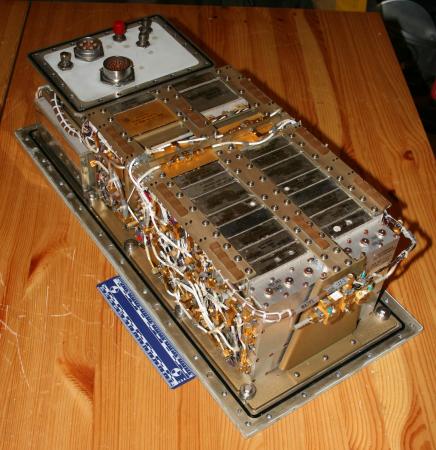Artifact: Transponder, Unified S-Band, Apollo Command Module, Block II
Aluminum, Copper, Silica, Stainless Steel, Gold
Apollo Command Module Unified S-Band Transponder (manufactured by Motorola, Inc., Military Electronics Division, Scottsdale, Ariz.). The Unified S-Band Transponder was the only method of exchanging voice communications, tracking, biomedical, and ranging, transmission of pulse code modulated (PCM) data and television, and reception of uplinked data from Mission Control once the Apollo Command Module was outside a range of 1500 nautical miles and line of sight from Manned Space Flight Network (MSFN) ground stations strung around the Earth (within that range, VHF was available). The term "Unified" is applicable because the communications system combined the functions of (signal) acquisition, telemetry, command, voice, television and tracking on one radio link. This design resulted in fewer antennas/electronics assemblies (and thus decreased complexity and weight) on both the spacecraft and the ground station segments of the MSFN. The Unified S-Band Equipment (USBE) onboard the Apollo Command Module, Lunar Module, Lunar Rover were absolutely critical to the successful execution of the Apollo program; and reliability was assured through the implementation of full redundant, heavily tested design.
The Electronic assembly hosts a redundant architecture consisting of two phase-locked transponders and one frequency modulated transmitter housed in single, gasket-sealed, machined aluminum case, 9.5 by 6 by 21 inches. The unit weighs 32 pounds, operated from 400 Hertz power, with RF output of 300 milliwatts, with a fixed transmit frequency of 2287.5 Megahertz (MHZ) / receive frequency 2106.4 MHZ.
The S-band transponder is a double-superheterodyne phase-lock loop receiver that accepted a phase-modulated radio frequency signal containing the updata and up-voice subcarriers, and a pseudo-random noise code when ranging was desired. This signal is supplied to the receiver via the triplexer integral to the S-band power amplifier equipment and presented to three separate detectors: the narrow- band loop phase detector, the narrow-band coherent amplitude detector, and the wide-band phase detector. In the wide-band phase detector, the intermediate frequency is detected, and the 70-kiloHertz up-data and kilohertz up-voice subcarriers are extracted, amplified, and routed to the up-data and up-voice discriminators in the premodulation processor.
When operating in a ranging mode, the pseudo-random noise ranging signal is detected, filtered, and routed to the S-band transmitter as a signal input to the phase modulator. In the loop- phase detector, the intermediate frequency signal is filtered and detected by comparing it with the loop reference frequency. The resulting dc output is used to control the frequency of the voltage-controlled oscillator. The output of the voltage controlled oscillator is used as the reference frequency for receiver circuits as well as for the transmitter. The coherent amplitude detector provided the automatic gain control for receiver sensitivity control. In addition, it detected the amplitude modulation of the carrier introduced by the high-gain antenna system. This detected output was returned to the antenna control system to point the high- gain antenna to the ground station. When the antenna pointed at the ground station, the amplitude modulation was minimized. An additional function of the detector was to select the auxiliary oscillator to provide a stable carrier for the transmitter, whenever the receiver lost lock. The S-band transponders could transmit a phase- modulated signal with the initial transmitter frequency obtained from one of two sources: the voltage controlled oscillator in the phase-locked disband receiver or the auxiliary oscillator in the transmitter. Selection of the excitation was controlled by a coherent amplitude detector.
The S-band equipment also contains a separate FM transmitter which permitted scientific, television, or playback data to be sent simultaneously to the ground while voice, real-time data, and ranging were being sent via the transponder.

